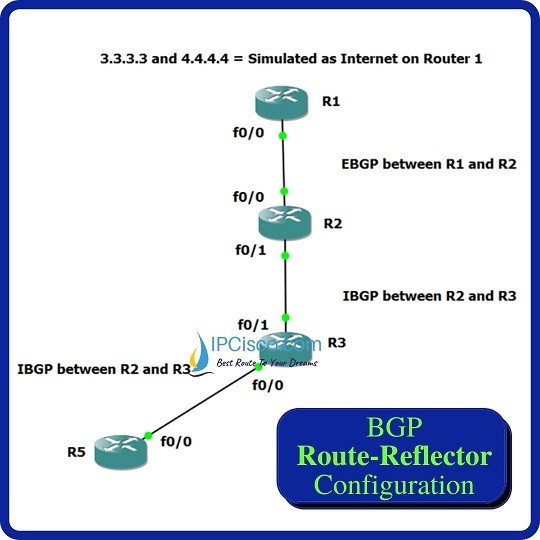- COURSES
- SPECIALS
- BLOG
- MEMBERS
- SHOP
- ABOUT
- ENROLL HERE

BGP Route Reflectors are very important in a BGP network. With this mechanism, we bypass Full Mesh iBGP configuration requirement. So, route reflectors reduce bandwidth and CPU usage in a network. So, how can we configure a Router reflector? In this lesson, we will learn Cisco BGP Route Reflector Configuration with GNS3.
For our BGP Route-Reflector configuration example, we will use the below GNS3 BGP topology.
In this GNS3 BGP Configuration example, we will do three main configurations. These are:
Now, let’s start to configure our network according to the given details.
You can also view Basic Cisco BGP Configuration Example on Packet Tracer
Table of Contents
We will start our Cisco BGP Router Reflector configuration example with Router 1. Router 1 will be in a different Autonomous System than other routers. On router 1, firstly we will create BGP process with the Autonomous System Number 200. Then, we will announce the networks 3.3.3.3 and 4.4.4.4. Lastly, we will configure EBGP peering with the remote BGP device.
R1(config)# router bgp 200 //Creating AS
R1(config-router)# network 3.3.3.3 mask 255.255.255.255 //Announcing networks
R1(config-router)# network 4.4.4.4 mask 255.255.255.255
R1(config-router)# neighbor 10.0.0.1 remote-as 100 //Creating EBGP peering
Router 2 will be in ASN 100. This is our Autonomous System that we will configure BGP router reflector. On Router 2, firstly, we will create BGP process with ASN 100. After that we will announce the networks. Then, we will configure EBGP peering and IBGP peering.
R2(config)# router bgp 100 //Creating AS
R2(config-router)# network 8.8.8.8 mask 255.255.255.255 //Announcing networks
R2(config-router)# network 11.11.11.11 mask 255.255.255.255
R2(config-router)# network 20.0.0.0 mask 255.255.255.0
R2(config-router)# network 30.0.0.0 mask 255.255.255.0
R2(config-router)# neighbor 10.0.0.2 remote-as 200 //Creating EBGP peering
R2(config-router)# neighbor 20.0.0.2 remote-as 100 //Creating IBGP peering
As an IGP, we will use OSPF in our Autonomous System 100. So, we will configure OSPF on Router 2.
R2(config)# router ospf 1 //Creating OSPF Process
R2(config-router)# network 10.0.0.0 0.0.0.255 area 0 //Adding networks
R2(config-router)# network 20.0.0.0 0.0.0.255 area 0
Router 3 will be our BGP Router Reflector. To configure Router 3 as router reflector we will use “route-reflector-client” keyword. Firstly, we will create BGP process, we will do the configuration of the IBGP peers. In the last step, we will use “route-reflector-client” keyword with neighbor command towards each IBGP peer.
Leave a Reply